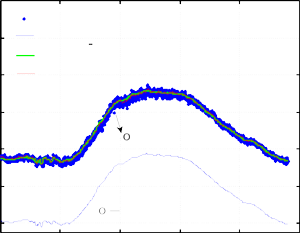Comparison of TEC estimation techniques using S1 and L5 signals of IRNSS
DOI:
https://doi.org/10.3103/S0735272718070038Keywords:
IRNSS, ionospheric time delay, TEC, relative TEC, IRS TECAbstract
Indian Regional Navigation Satellite System (IRNSS) is a satellite based navigation system developed by Indian Space Research Organization (ISRO). The positional accuracy of IRNSS is limited by several errors including ionospheric delay. Ionospheric delay can be estimated with precise calculation of total electron content (TEC). However, TEC is biased by multipath and thermal noise. Therefore, multipath and thermal noise free relative TEC measurements are made and compared with two other methods, namely, code TEC and IRNSS Receiver Software (IRS) techniques. In this investigation L5 (1176.45 MHz) and S1 (2492.028 MHz) signals from IRNSS 1A to 1G satellites are considered. The results indicate that relative TEC estimation technique removes the multipath and thermal noise from the TEC measurements. Further, the TEC for signals coming from various IRNSS satellites are evaluated by calculating the standard deviation (SD). In the analysis the data is divided into segments with duration of 1 h each. The results indicate that SDs for the relative TEC estimation (2.5 TECU in case of IRNSS 1B) are lesser than the other two techniques indicating the relative TEC can be used in the receiver for the estimation of ionospheric delay. Further, the high ratio of the operating frequencies indicates a better TEC estimation.References
- MOHD, Q.J.; ACHANTA, D.S.; SUPRAJA, Reddy A.; SRIDHER, T.; NALAM, V.K.R.; PANT, T.K. “Multipath and thermal noise free relative TEC estimation using IRNSS L5 and S1 signals,” Proc. of Int. Conf. on Innovative Technologies in Engineering, ICITE-2018, 11-13 Apr. 2018, Hyderabad, India, 2018.
- SRINIVAS, V.S.; SARMA, A.D.; ACHANTA, H.K. “Modeling of ionospheric time delay using anisotropic IDW with Jackknife technique,” IEEE Trans. Geosci. Remote Sensing, v.54, n.1, p.513-519, 2016. DOI: https://doi.org/10.1109/TGRS.2015.2461017.
- YEDUKONDALU, K.; SARMA, A.D.; VEMURI, S.S. “Estimation and mitigation of GPS multipath interference using adaptive filtering,” PIER M, v.21, p.133-148, 2011. DOI: http://doi.org/10.2528/PIERM11080811.
- LANGLEY, R.B. “GPS receiver system noise,” GPS World, p.40-45, June 1997.
- NADARAJAH, N.; KHODABANDEH, A.; TEUNISSEN, P.J.G. “Assessing the IRNSS L5-signal in combination with GPS, Galileo, and QZSS L5/E5a-signals for positioning and navigation,” GPS Solut., v.20, n.2, p.289-297, 2016. DOI: https://doi.org/10.1007/s10291-015-0450-8.
- WALTER, T.; GUNNING, K.; BLANCH, J. “Improved ephemeris monitoring for GNSS,” Proc. of ION Int. Tech. Meeting, 25-28 Jan. 2016.
- RAO, V.G.; LACHEPELLE, G. “Proposed dual frequency signal design for optimal TTFF in IRNSS,” Proc. of Pearl Jubilee Int. Conf. on Navigation and Communication, 20-21 Dec. 2012, Hyderabad, India, 2012.
- http://www.isro.gov.in.
- “IRNSS signal in space ICD for standard positioning service,” v. 1.0, June 2014, ISROIRNSS-ICD-SPS-1.0, Indian Space Research Organization (ISRO), Bangalore.
- CARRANO, C.; GROVES, K. “Ionospheric data processing and analysis,” Proc. of Workshop on Satellite Navigation Science and Technology for Africa, March 23 – April 9, 2009, The Abdus Salam ICTP, Trieste, Italy. 2009.
- HOFMANN-WELLENHOF, B.; LICHTENEGGER, H.; COLLINS, J. Global Positioning System, 5th ed. Springer-Verlag Wien, 2001. DOI: http://doi.org/10.1007/978-3-7091-6199-9.

Downloads
Published
2018-08-02
Issue
Section
Research Articles

